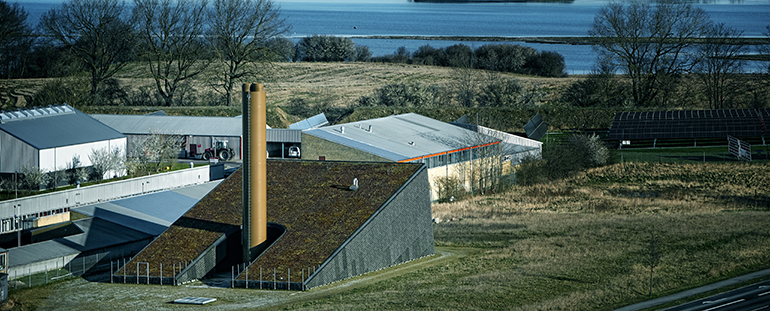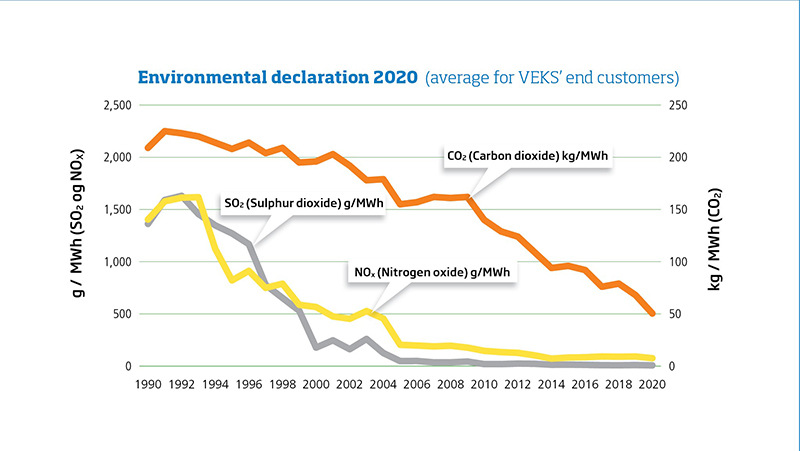
Case 4, VEKS' Annual Review 2020
Surplus heat, CHP, waste heat, CO2 neutral district heating, climate friendly heat... Many terms – but what characterises VEKS’ district heating?
CHP
When VEKS “started operation” on 1 October 1987, the purpose was to save resources. The fewer re-sources the less environmental impact. Back then with the new transmission system, VEKS could to-gether with CTR utilise the surplus heat partly from waste incineration, partly from the large central CHP plants –VEKS primarily used Avedøre CHP Plant. The first big step was to connect the local district heat-ing companies in VEKS’ supply area to the transmission system. Thus, fuel oil, coal, and natural gas, which until then had been fuel in the local boilers, could now be replaced by district heating from VEKS – a process which was realised in 1990.
Surplus heat from waste incineration and CHP alone has resulted in an annual CO2 reduction of approx. 500,000 tonnes compared to if the customers had used oil or natural gas for heating.
From 1990 to 2000, VEKS aimed to reduce the emissions of CO2 where the focus was first and foremost on replacing fuel oil with light gas oil or natural gas at the peak and reserve load centrals. Secondly, VEKS’ energy consultancy focuses on lowering the return temperature in the transmission system. A lower return temperature reduces heat loss and power consumption from pumping but also ensures an improved efficiency at Avedøre CHP Plant.
Moreover, 1990 is the year which is subsequently used as reference year to calculate the CO2 emission to which the district heating customers in VEKS’ supply areas have given rise.
Sustainable biomass
In 2001, unit 2 of Avedøre CHP Plant was commissioned. The heat production of the new unit was based on natural gas and wood pellets which played a crucial role in connection with the CO2 emissions in the years ahead.
The Danish Energy Agreement from 2012 legislatively opened up - for Ørsted as the owner of Avedøre CHP Plant as well as VEKS - to adapting Unit 1 of Avedøre CHP Plant from coal to sustainable biomass, rendering it a financially attractive solution.
The same year, VEKS purchased the biomass-fired CHP plant in Køge which covers more than 10% of VEKS’ present overall heat requirements.
Since 2016, Denmark’s largest CHP plant, Avedøre CHP Plant, has produced heat from both units based on 100% sustainable biomass and thus replaced fossil the fuels, coal, and natural gas.
The biomass conversion at Unit 1 alone has resulted in an annual CO2 reduction of approx. 100,000 tonnes compared to if the heat production were based on coal.

VEKS’ customers have reached the goal
With the Climate Treaty from June 2020, a large majority in the Danish Parliament decided that Den-mark should reduce their CO2 emissions by 70% in 2030 compared to 1990. And what is VEKS’ stance considering this goal?
The national goal to reduce the CO2 emissions by 70% in 2030 has already been reached in VEKS’ sup-ply area.
In 1990, the CO2 emissions from a district heating customer in VEKS’ supply area was 58.22kg/GJ whereas it was reduced to 14kg/GJ in 2020. This corresponds to a reduction of 75.9% since 1990. Thereby, district heating customers in VEKS’ supply area have reached the goal when it comes to the national goals which do not apply until 2030.
As a natural gas customer, the emissions from the residence is still 56.5kg CO2/GJ. On the whole, it corresponds to the CO2 emissions of a district heating customer in VEKS’ supply area in 1990. By con-verting natural gas to district heating, you can all at once surpass the national CO2 reduction goals of 70%.
VEKS’ projects
VEKS is involved in a number of projects where all their goals contribute to the green transition – you save resources and thus reduce the CO2 emissions.
CP Kelco
Together with VEKS, CP Kelco has developed a project where surplus heat covers the heat requirements of 2,200 households – connected to Køge District Heating.
Originally, the focus was on lowering the noise level from CP Kelco’s cooling towers whose fan heaters produced noise when the surplus heat was blown away. A stressful noise problem was transformed into a surplus heat project where VEKS utilises the present surplus heat in the local district heating system instead of sending the heat up in the air in a noisy manner as it used to.
The effect of the CP Kelco project represents approx. 1.5% of VEKS’ total heat purchase and was official-ly opened 9 April 2018 by Lars Christian Lilleholt, the former Minister in power.
The surplus heat project alone has resulted in an annual CO2 reduction of approx. 10,000 tonnes com-pared to if the customers still used natural gas for heating.
VEKS Gasmotor
In the summer of 2015, Solrød Biogas A/S started producing gas. The annual production of biogas is approx. six million cubic metres for VEKS’ gas engine in Solrød. VEKS is involved in the project as the taker – the buyer of the biogas. At the heating plant in Solrød, VEKS has constructed a building for the purpose. It contains a gas engine which produces green electricity for the grid through a generator and at the same time it transforms the cooling water to district heating for VEKS’ system.
VEKS’ gas engine generates around 25,000MWh (25 million kWh) green electricity a year. The heat from the gas engine covers 1% of VEKS’ total sale of heating.
More coming up
Through the years, VEKS has “collected heat” where it made sense. And more is on the way.
At present, experiences from a collaborative project about large heat pumps also involving VEKS are reaped concurrently with large-scale geothermal energy in the Copenhagen metropolitan area being a highly prioritised development area.
Together with Høje Taastrup District Heating, VEKS will put a pit heat storage of 70,000m3 into service in 2021/2022. The project has received EUDP aid which is the Danish Energy Agency’s funds to sup-port development projects.
The pit heat storage will utilise the district heating even better, as the district heating will be deposited when it is low-cost to produce - reversely, the stored heat will be used when it is too expensive to pro-duce. Therefore, the new deposit will benefit the total power and heat production in the entire Copenha-gen metropolitan area and will thus also benefit the green transition – especially because the local peak load production based on fossil oil or natural gas can be reduced.
The pit heat storage alone will result in an annual CO2 reduction of up to 15,000 tonnes.